What's Size Got To Do with It?
Understanding the distribution of business by size is a necessary element of economic development planning at both the state and local levels. This article examines the distribution of Indiana's businesses by employment size and wages. The data, collected as part of the quarterly U.S. Bureau of Labor Statistics Covered Employment and Wages Survey, represent Indiana for the quarter ending in March 2000.
The first step in such an analysis is to define establishment size classes. According to the Small Business Administration (SBA), large establishments employ 500 or more workers. For this study, however, any establishment with employment greater than 250 is considered a large establishment. This is done for two reasons. First, like establishments with greater than 500 employees, establishments with employment between 250 and 499 also constitute a very small segment of Indiana establishments (0.7%). Second, while an establishment of this size ceasing operation in Marion or Elkhart Counties would have minor repercussions, it could have a major impact on smaller Indiana counties, such as Orange, Fulton or Randolph. It is important to understand that we are discussing single locations. For example, while some retailers are among the state's largest employers, there are very few retail establishments with 250 or more employees.
Small establishments represent the majority of all Indiana establishments, while large establishments are the major employers and wage payers. Establishments with fewer than four employees account for more than 45% of all the single establishments in Indiana (see Figure 1).
Click on image below to see a larger version.
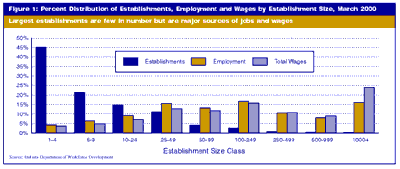
Establishments with fewer than 50 employees account for more than 92% of all Indiana establishments. Large establishments, on the other hand, account for only 1.2% of all Indiana establishments (see Table 1). Yet, while great in number, smaller establishments are not the dominant employers by employment or wages; that is the realm of large establishments. Indiana's 1,462 large establishments also account for more than 34% of all employment and more than 43% of all wages paid. In real terms, this means these large establishments account for more than 1 million Indiana employees and more than $10 billion in wages paid.
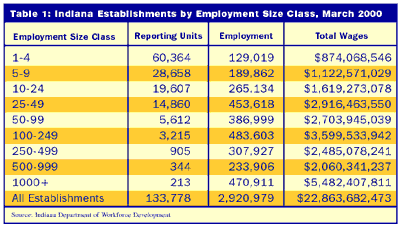
Although these results are derived from labeling establishments with employment greater than 250 as large establishments, we can get similar results with different criteria. For example, if the SBA criterion is used, large establishments account for only one-half of 1% of all establishments, but still total nearly a quarter of Indiana employment and a third of all wages. If large establishments include those with 100 or more employees, they account for less than 4% of all establishments but more than half of Indiana employment and nearly 60% of all wages. Any way we define large establishments, we arrive at the same conclusion: Large Indiana establishments are few in number, but dominate Indiana employment and wages.
Large establishments not only comprise a higher share of total wages, but also pay higher average wages than smaller establishments (see Figure 2). Explanations for this difference are many and varied. Larger establishments may have more high-wage executive positions, pay bonuses or be unionized. Interestingly, the smallest employment class is not the lowest-paying category. A variety of explanations may account for this, but the most probable is that high-wage small consulting firms may skew the overall average upward.
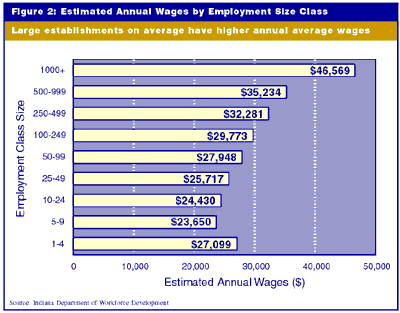
What industry sectors are most likely to have large establishments? Figure 3 shows the distribution by industry of the Indiana establishments with more than 1,000 employees. Manufacturing, which includes primary metals and transportation equipment, accounts for more than 40% of large establishment employment. The public sector, made up of Health Services, Government and Education Services, constitutes 41% of employment. Indiana's largest employers are a combination of schools, hospitals, government and manufacturers.
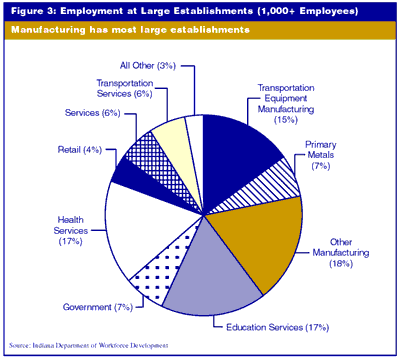
The distribution of establishments by size at the county level should be of particular interest to local economic developers as they plan retention and attraction strategies for their area. The availability of establishment size data for the majority of Indiana counties, however, cannot be disclosed because of confidentiality restrictions on releasing data that could reveal the operations of individual establishments.
Some general information, however, can be drawn from the data. For example, in 87 counties, establishments with between one and four employees account for 40% of all establishments. The situation reverses when employment and wages are considered. Establishments of this size account for less than 10% of county employment in 89 counties and wages in 91 counties. At the opposite end of the spectrum, in no county do establishments with 1,000 or more employees account for more than 10% of establishments. They represent less than 10% in 48 counties, and 44 counties have no establishments of this size. Of the 48 counties with establishments of 1,000 or more employees, they account for 10% or more of employment and wages in 40 and 43 counties, respectively. In 13 counties, they account for 20% or more of employment, and in 26 counties they account for 20% or more of wages. In one county, large establishments account for more than 70% of wages. Other large size classes also play an important role. Establishments with between 100 and 250 employees account for 20% or more of employment and wages in 25 and 28 counties, respectively.
If we focus on wages, the area in which large establishments are most prevailing, we find 40 Indiana counties in which large establishments account for 40% or more of wages (see Figure 4). More detail is not available due to confidentiality restrictions, but we can say that in 17 of these counties, large establishments account for more than 50% of wages. A number of counties listed are large urban centers with many large establishments. Marion County alone has 49 establishments with employment greater than 1,000. Most of the other counties have less employment, but have one or more large establishments. These are more likely to have a higher percentage of large-establishment employment than do the large urban counties.
Click on the map below to see county names.
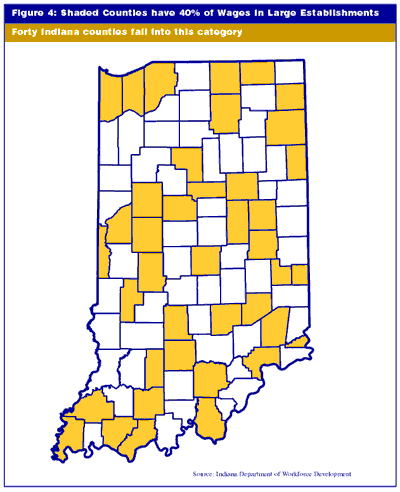
The final aspect to consider is what would happen if the largest establishment in a county would suddenly cease operation. While this may be of the most interest, it is also the limiting aspect of confidentiality restrictions. In 41 counties, such a closing would involve less than 10% of all county wages (see Table 2). For 33 counties, the impact increases to between 10% and 19%. The number of counties decreases to just nine for the 20% to 29% range, but for the remaining nine counties, wages affected would be 30% or more. In four of the counties in the latter group, the largest employer accounts for more than 50% of all wages. It should be noted that if this large employer were to leave, it would impact more than just the immediate county. In many of these counties, evidence suggests employees are not only from the local county, but from neighboring counties as well.
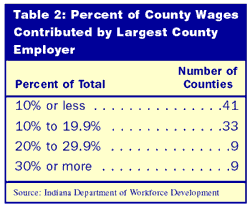
This information demonstrates that large establishments still play a major role in the Indiana economy. This is true not only in the area of employment, but more importantly, in what they contribute in wages. Large establishments also play a major role in the national economy. While comparable Bureau of Labor Statistics data are not available, data from county business patterns and the 1997 Economic Census indicate that nationally, large establishments are few in number, but constitute a major share of employment and wages. Thus, while there is always a risk of sustaining an industry that has reached the end of its product life cycle, the support and retention of these large establishments, where practical, is sound economic policy at all levels of government.
